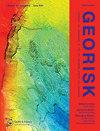基于机器学习的隧道围岩实时智能分类模型及其应用
IF 4.8
3区 工程技术
Q1 ENGINEERING, GEOLOGICAL
Georisk-Assessment and Management of Risk for Engineered Systems and Geohazards
Pub Date : 2023-01-02
DOI:10.1080/17499518.2023.2182891
引用次数: 2
摘要
围岩等级的实时准确预测是隧道动态施工和设计的关键。然而,国际公认的半定量方法(如岩体评级(RMR)、Q和基本质量(BQ))无法在施工中提供快速准确的分类。本研究提出了一种智能围岩分类方法和隧道信息管理系统,可以实时准确地预测围岩等级。收集了中国286个案例的数据库,包括7个地质参数和围岩等级。基于不同的训练参数,使用VGGNet、ResNet和支持向量机(SVM)算法建立了12个分类模型。SVM分类器的准确率为93.02%,优于VGGNet和ResNet分类器。此外,精度、召回率、F-测度、受试者操作特征(ROC)和20个案例验证表明,SVM分类模型在小样本和不平衡样本的学习和泛化方面具有更大的鲁棒性。此外,利用云技术开发了一个隧道信息管理系统,可以在10s内准确预测围岩等级。总之,本研究的成果可以为交通隧道和地下厂房的实时岩体分类提供有价值的参考。本文章由计算机程序翻译,如有差异,请以英文原文为准。
A real-time intelligent classification model using machine learning for tunnel surrounding rock and its application
ABSTRACT Real-time and accurate prediction of surrounding rock grade is crucial for tunnel dynamic construction and design. However, the internationally accepted semi-quantitative methods (e.g. rock mass rating (RMR), Q, and basic quality (BQ)) cannot provide fast and accurate classification in construction. This study proposed an intelligent surrounding rock classification method and a tunnel information management system, which can predict the surrounding rock grade in real-time and accurately. A database is collected with 286 cases in China, including seven geological parameters and surrounding rock grades. Based on different training parameters, 12 classification models are established using VGGNet, ResNet, and support vector machine (SVM) algorithms. The accuracy of the SVM classifier is 93.02%, which performs better than the VGGNet and ResNet classifiers. Moreover, precision, recall, F-measure, receiver operating characteristic (ROC), and 20-case verification show that the SVM classification model has greater robustness in learning and generalising for small and imbalanced samples. Additionally, a tunnel information management system is developed with cloud technology, which can accurately predict the surrounding rock grade within 10 s. Overall, the achievements of this study can provide valuable references for real-time rock mass classification in traffic tunnels and underground powerhouses.
求助全文
通过发布文献求助,成功后即可免费获取论文全文。
去求助
来源期刊
CiteScore
8.70
自引率
10.40%
发文量
31
期刊介绍:
Georisk covers many diversified but interlinked areas of active research and practice, such as geohazards (earthquakes, landslides, avalanches, rockfalls, tsunamis, etc.), safety of engineered systems (dams, buildings, offshore structures, lifelines, etc.), environmental risk, seismic risk, reliability-based design and code calibration, geostatistics, decision analyses, structural reliability, maintenance and life cycle performance, risk and vulnerability, hazard mapping, loss assessment (economic, social, environmental, etc.), GIS databases, remote sensing, and many other related disciplines. The underlying theme is that uncertainties associated with geomaterials (soils, rocks), geologic processes, and possible subsequent treatments, are usually large and complex and these uncertainties play an indispensable role in the risk assessment and management of engineered and natural systems. Significant theoretical and practical challenges remain on quantifying these uncertainties and developing defensible risk management methodologies that are acceptable to decision makers and stakeholders. Many opportunities to leverage on the rapid advancement in Bayesian analysis, machine learning, artificial intelligence, and other data-driven methods also exist, which can greatly enhance our decision-making abilities. The basic goal of this international peer-reviewed journal is to provide a multi-disciplinary scientific forum for cross fertilization of ideas between interested parties working on various aspects of georisk to advance the state-of-the-art and the state-of-the-practice.

 求助内容:
求助内容: 应助结果提醒方式:
应助结果提醒方式:


